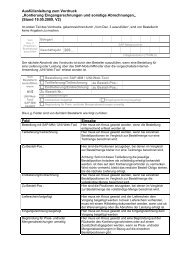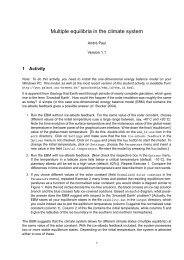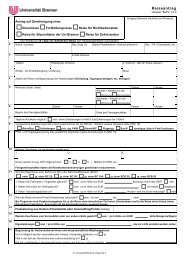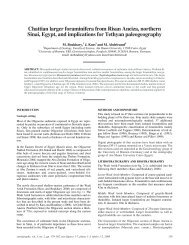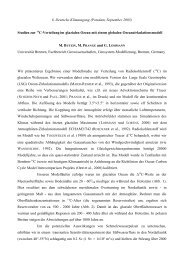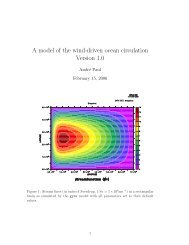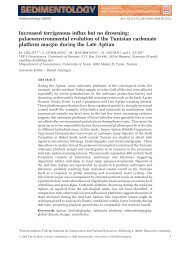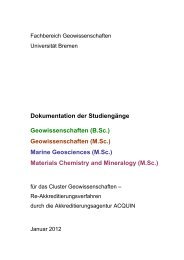Forschung im HLRN-Verbund 2011
Forschung im HLRN-Verbund 2011
Forschung im HLRN-Verbund 2011
- Keine Tags gefunden...
Erfolgreiche ePaper selbst erstellen
Machen Sie aus Ihren PDF Publikationen ein blätterbares Flipbook mit unserer einzigartigen Google optimierten e-Paper Software.
52Unstructured Mesh Ocean ModellingGlobal and regional ocean-ice s<strong>im</strong>ulations using FESOM: Toward applications withvariable resolution and regional focusP. Lemke, Q. Wang, D. Sidorenko, S. Danilov, J.Schröter, L. Nerger, Alfred Wegener Institute forPolar and Marine ResearchAbstract• The Finite Element Sea ice-Ocean Model (FE-SOM) developed at AWI provides the possibilityto s<strong>im</strong>ulate ocean and sea-ice on global unstructuredmeshes with a regional focus. Finescaleprocesses can be studied with less computationalresources than in traditional models usingfine resolution everywhere.• A global FESOM setup is validated using cl<strong>im</strong>atologyforcing. The model results compare wellwith those from other models driven by the sameforcing.• The formation process of Antarctic Bottom Waterin the western Ross Sea is studied using FESOMwith variable resolution. Tides can increase thebottom water outflow rate by 70% in our models<strong>im</strong>ulations.S<strong>im</strong>ulations with global sea ice-ocean models arewidely used to assist in understanding cl<strong>im</strong>ate dynamics.The Finite Element Sea ice-Ocean Model(FESOM) developed at AWI is a novel ocean generalcirculation model allowing one to s<strong>im</strong>ulateocean and sea-ice on unstructured meshes withvariable resolution. Local mesh refinement withoutnesting and a realistic representation of coastlinesand bottom topography is possible with FE-SOM. It consists of the Finite Element OceanModel (FEOM) coupled with a finite element seaice model [1] [2].Since FESOM numerics are essentially differentfrom those of regular grid models, model intercomparisonstudies are essential to assess the longtermperformance of FESOM against other modelswell approved by the oceanographic community.The feedbacks from such studies can help tofurther <strong>im</strong>prove the model with respect to both numericsand parameterizations. In this project wevalidated the model in a global setup under theCORE (Coordinated Ocean-ice Reference Exper<strong>im</strong>ents)framework, as it provides a common referencepoint for research groups developing and analyzingglobal ocean-ice models. The model wasrun for 500 years under repeating normal year cl<strong>im</strong>atologyforcing. The model results agree wellwith previous studies in terms of hydrography, seaice, heat and volume transport, and their long termtrend as well [3]. It is demonstrated that FESOMhas become a reliable tool for studying the oceangeneral circulation.In the ocean it frequently happens that localized,small-scale dynamics have <strong>im</strong>pact on the large oreven global scale. A very fine resolution is usuallyrequired to properly resolve them in numericals<strong>im</strong>ulations. To include their effects on the largeor even global scale it is computationally beneficialto use unstructured mesh models, which allowfor variable resolution with focus on these particularregions. Many regional studies performedthus far have been using regional configurationswith prescribed open boundaries. Models formulatedon unstructured meshes overcome this difficultyby seamlessly embedding the refined regionsin a larger domain or even in the global ocean. Besides,many <strong>im</strong>portant geometric and bathymetricfeatures in the ocean can only be resolved if a regionalfocus is allowed.The Antarctic Bottom Water (AABW) is an <strong>im</strong>portantingredient of the global meridional overturningcirculation. It feeds the coldest part of the globalbottom water and spreads at the sea floor overroughly twice the area covered by the North AtlanticDeep Water (NADW). AABW forms mainlyin a few regions in the Southern Ocean. Here weexploit FESOM to study the bottom water formationprocess in the western Ross Sea. S<strong>im</strong>ulating overflowsin the western Ross Sea requires a very highmesh resolution. This is not only due to the smallnessof the baroclinic Rossby radius in this region(∼6 km), but also because of the need to resolvesmall topographic features which can be <strong>im</strong>portantfor both steering and mixing effects. High meshresolution is also required to adequately s<strong>im</strong>ulatethe plume water over steep continental slopes (withslopes larger than 0.1 in many regions). A meshwith 0.5 km horizontal resolution in a coarse resolution(30 km) setup is used in this work. Theresearch focuses on the tidal <strong>im</strong>pact on overflowdynamics and bottom water production rate [4].The overflow from the western Ross Sea exhibitspronounced variability at both daily and springneaptidal t<strong>im</strong>e scales. Tides increase mixing overboth the outer shelf and upper slope there. Plumejets are shaped by tidal currents at a bathymetricbend west of the mouth of the Drygalski Trough,descending rapidly and supplying the bottom water(see Figure 1). A fraction of shelf water remainsover the shelf and propagates westward from theRoss Sea, but it does not contribute significantly toGeowissenschaften



